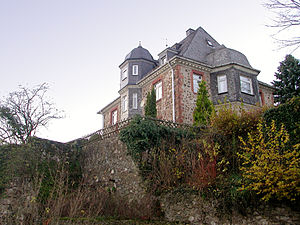Koenigsberg Castle (Biebertal)
| Koenigsberg Castle | ||
|---|---|---|
|
"Castle" on the castle walls |
||
| Creation time : | Middle or second half of the 13th century | |
| Castle type : | Höhenburg, summit location | |
| Conservation status: | Wall remains | |
| Standing position : | Landgraves | |
| Place: | Biebertal - Koenigsberg | |
| Geographical location | 50 ° 38 '40.8 " N , 8 ° 32' 7.9" E | |
|
|
||
Königsberg Castle was built on a summit above the Königsberg part of the municipality of Biebertal in the district of Gießen in Hesse in the middle or in the second half of the 13th century by the Counts of Solms .
history
Presumably the summit castle was built by Count Marquard von Solms (1225–55) to secure an old road and to control the territory. Around 1250 the county was divided into the territories of Solms-Königsberg (until 1363), Solms-Burgsolms (until 1416) and Solms-Braunfels . Soon afterwards a separate line of the family formed, presumably due to the distance to the southern possessions, because Marquard's son, Count Reinbold von Solms (1255–73), called himself Count von Cunigesberg in 1257 (and again in 1266).
Due to the Hesse-friendly policy of this line, the relationship with the cousins von Braunfels and Burgsolms was always tense. Königsberg Castle lost its importance as a base, so that between 1321 and 1323 Hohensolms Castle was built directly across from Königsberg .
In 1331 Count Philipp von Solms opened his castles of Solms and Königsberg to the Mainz monastery administrator Archbishop Balduin von Trier . In 1350, Landgrave Heinrich II of Hesse bought the castle for 2,000 guilders . The count was allowed to live in the castle until his death. With him the line of the Solms-Königsberger died out in 1364. The castle itself was occupied by castle men and the seat of the Hessian office of Königsberg .
1468–1517 the castle was again pledged to the Counts of Solms.
In 1500 the settlement that arose next to the castle was first mentioned as a "city" in a document. During the Thirty Years War (1647) the town and castle were burned down by Swedish troops. In 1820/27 the office of Königsberg was canceled. After that, a chief forester's office had its seat on the "castle".
In 1840 the castle still consisted of an office building with an extension, an office barn, a tithe barn , a fruit store and two pigsties. The city of Königsberg bought these buildings from the Prince of Braunfels and had them torn down in 1873/74 because they were in disrepair. The stones from the demolition could be used by private individuals.
In 1922 the area with all building remains was sold to the teacher Christian Haibach by the Prince of Solms-Lich for 2000 gold marks. Teacher Hermann Tamschick planned the construction of a two-story, villa-like building, whereby the conservator at the Gießen building authority made him an obligation to create a “castle-like” building. So on the remaining high retaining walls, the cellar vaults, the piece of circular wall with the remains of the round tower and the remains of the foundations of the palace, a two-story residential building, which is now called the "castle".
From the former summit castle only the circular kennel and ring wall and an old defense tower are preserved.
literature
- Königsberg Castle and the castle settlement . In: Heimat an Lahn and Dill 17 , 1970, pp. 3–4.
- Julius Brumm: Königsberg in Nassau . In: Nassovia 15 , 1914.
- Willi Görich: Königsberg Castle south of Hohensolm . In: From the past , Marburg 1952, No. 101
- Rudolf Knappe: Medieval castles in Hessen. 800 castles, castle ruins and fortifications. 3. Edition. Wartberg-Verlag, Gudensberg-Gleichen 2000, ISBN 3-86134-228-6 , p. 292.
Web links
- State Office for Monument Preservation Hessen (Hrsg.): Remains of the castle Königsberg and residential house In: DenkXweb, online edition of cultural monuments in Hessen
- www.burgenlexikon.eu Koenigsberg Castle
- Tonia Simone Pöppler: Medieval castles, palaces and ruins in the Gießen district, part 7: Königsberg Castle. In: Gießener Zeitung of March 21, 2009
- www.biebertal.de Section history of Königsberg
Individual evidence
- ↑ Valentin Ferdinand Guden: Codex diplomaticus exhibens anecdota Moguntiaca ius Germanicum, et SRI Historiam illustrantia . Vol. 1–3, Göttingen 1743–1751.
- ^ Heinrich Otto (arr.): Regesten der Archbishop von Mainz von 1289-1396 , first section, second volume 1328-1353. ND of the Darmstadt edition 1932–1935, Aalen 1976.
- ^ Helfrich Bernhard Wenck : Hessian national history. With a document book . 3rd volumes. Frankfurt, Leipzig 1789-1803.




